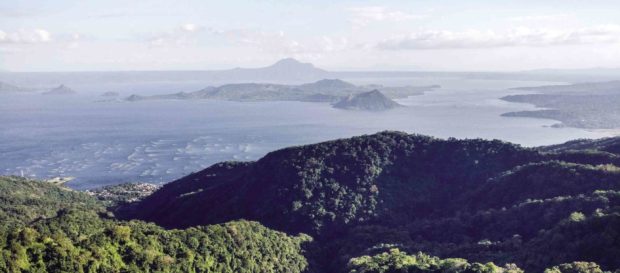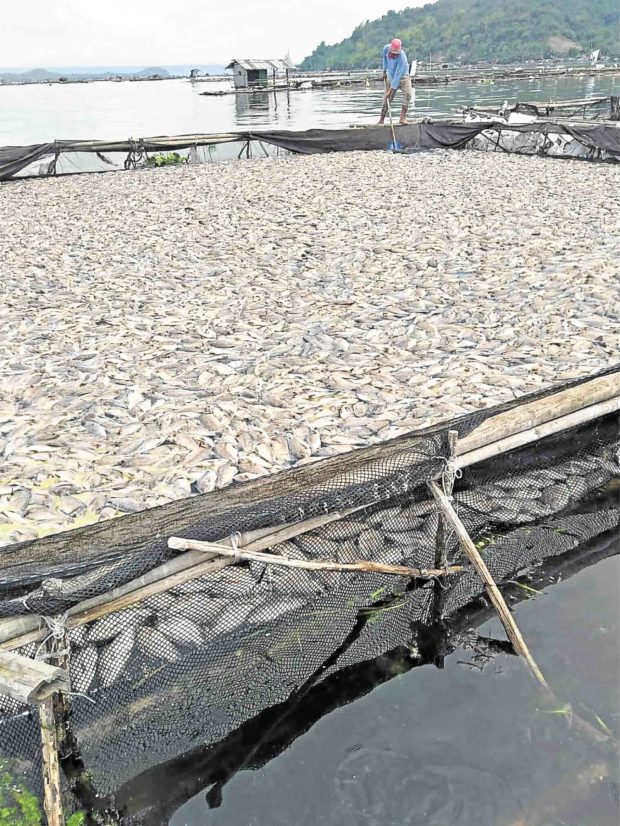Fishkill prompts tighter policy on Taal Lake use

AQUACULTURE ZONE Sections of Taal Lake have been turned into an aquaculture zone, where fish cage operators grow tilapia and “bangus” (milkfish). —REM ZAMORA
MANILA, Philippines — The Department of Environment and Natural Resources (DENR) is looking at improved water conditions in Taal Lake days after its dissolved oxygen level dropped, killing 605 metric tons of tilapia grown in fish cages at Laurel and Agoncillo towns in Batangas province.
Maria Paz Luna, DENR director in Calabarzon (Cavite, Laguna, Batangas, Rizal and Quezon) region, said last week’s lake “crisis,” which led to a P42.9-million industry loss, had prompted the agency to review the lake’s carrying capacity and management plans.
“We now have an imprimatur to hasten what we were going to do … with this happening too often,” Luna said in a telephone interview on Monday.
Monitoring by the Bureau of Fisheries and Aquatic Resources on Monday showed the oxygen level back to normal at 6 parts per million (ppm) at the lake’s surface level, after it went down to as low as 0.86 ppm last week.
Fish, like tilapia and “bangus” (milkfish) which are cultured in fish cages in Taal Lake, require an oxygen level of between 5 and 6 ppm in order to survive.
Article continues after this advertisementViolations
Article continues after this advertisementBut while an oxygen level drop is generally considered a natural phenomenon, normally triggered by weather conditions, the DENR said it was also about time to review its regulations on aquaculture.
“It was a combination of natural [and man-made causes]. The industry took a risk and here is nature’s way of getting back,” Luna said.
The DENR said it found a number of violations by cage operators such as overstocking and overfeeding. It also said cage owners skirted government policies, with many failing to build pits for dead fish.
It also discovered that many cages were owned by big corporations and feed mills. “We learned that some residents would lease their permits [to own a fish cage] to corporations,” Luna said.
Moratorium
The government, in 2006, had set the ideal carrying capacity of the lake to 6,000 fish cages. Records showed that at least 14,000 cages were operating in the lake that year and it took the government five years, or in 2011, to reach the carrying capacity that it set.
But Luna said the DENR might review the carrying capacity and lower it further, given the present conditions like growing tourism and infrastructure around the lake.

LOSSES Fish cage operators in the towns of Agoncillo and Laurel in Batangas province lost at least P42.9 million after their tilapia stock in Taal Lake turned belly up last week. —PHOTO COURTESY OF DENR CALABARZON
She said her agency was also looking at implementing a single growth cycle, from the current twice a year, to allow the lake “to rest.” This means that fish stocking will not be allowed from January to May as reduced oxygen level and sulfur upwelling, which commonly triggers a fishkill, happen during this time of the year.
Duterte concern
In Manila, President Rodrigo Duterte has ordered government agencies to undertake measures to minimize the impact of the recent fishkill in Taal Lake.
“The President has expressed concern about the fishkill in Taal, which according to fisheries experts is caused by sulfur [upwelling] triggered by the strong ‘amihan’ that accompanies an extreme temperature drop,” presidential spokesperson Salvador Panelo said in a statement on Monday.
Panelo said the President had directed appropriate government offices to “closely monitor the situation, particularly the water quality in Taal Lake.”
“He (Mr. Duterte) ordered increased vigilance over the prices and supplies, as well as the freshness of fish sold in the market,” Panelo added. —With a report from Julie M. Aurelio